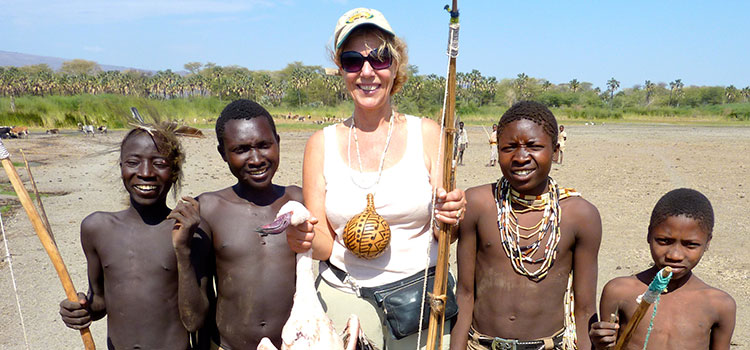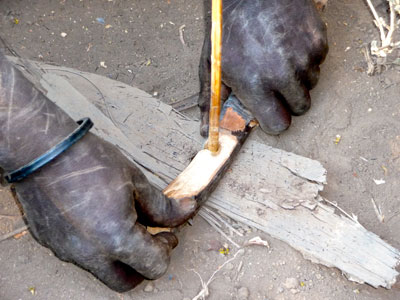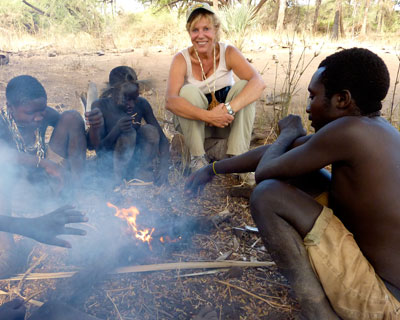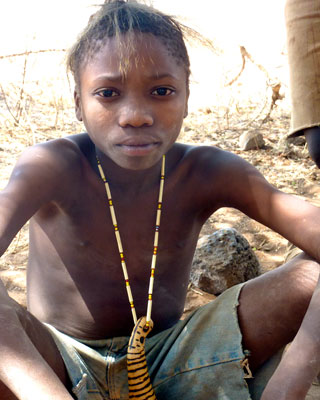Hunting with the Hadza
by Suzi Colman; Commerce, MI
It was the best time of my life. Well, maybe my marriage or the birth of our children or our grandson were the best days of my life, but the two days I spent with the Hadza tribe of Tanzania were the most exciting I have ever experienced.
The Hadza people
I have always had an interest in old tribal ways. If I had my life to do over again, I probably would major in anthropology, but at this stage of my life, at the age of 63, I will stick to pursuing my love of learning about tribes as a hobby.
My husband, Jon, and I traveled to Tanzania for a safari in September-October 2011. While we were there, we went to a remote region near Lake Eyasi where there is a nomadic tribe called the Hadza, or Hadzabe, that still maintains their traditional life as hunter-gatherers. They have rejected adapting to modern civilization, resisting even such things as owning cows or goats or becoming farmers.
It was a 2½-hour drive from Ngorongoro Crater on extremely bumpy, dusty roads. When we arrived with our local guide, Hassan, we were welcomed by the Hadza to go hunting with the men or berry picking with the women.
At a young age, Hassan, who grew up in a neighboring Iraqw village, befriended a Hadza boy and learned their unique clicking language. Only a handful of people can understand this language.
An exciting excursion
We arrived in the early afternoon, so we had missed the morning hunt, but, for some reason that I didn’t understand, four of the hunters decided to go hunting again, so Hassan and I went with them. One of the hunters promptly killed a bird with a bow and arrow, tucking it in his shorts as if it were a cell phone.
We then walked on to Lake Eyasi, which was mostly dry at that time of the year. I soon found out that the tribe had shot a flamingo that morning but it had gotten away, so that’s why they wanted to go back out in the afternoon. They did find the dead flamingo.
As we were walking on the dried-out lake, all of a sudden a hippo popped out of a nearby watering hole. Now, I know that hippos are very dangerous when a person gets between them and the water, and this hippo was already in the water, but I still felt unsafe. Hassan told me not to worry because he would take care of me.
I couldn’t figure out how he could protect me from a hippo since he didn’t have a gun, but he told me he had a Swiss army knife. Wow — that blade was a whole three inches long!
He also told me that the Hadza would take care of me. The tribe members approached the watering hole and threw rocks at the hippo while making all kinds of weird yelling noises. The hippo growled back.
I realized that if the hippo decided to attack, those guys could run as fast as lightning and I would be the weak link, so I asked Hassan to ask them if we could leave. These nice people just turned around and we left. Maybe I had overreacted, but I felt much better when we had some distance between the hippo and us.
After we got off the lake, we sat on the ground and, rubbing two pieces of wood together, they started a fire. The flamingo was thrown onto the fire, feathers and all. After stripping the burned feathers, they turned the bird, reaching into the fire with their bare hands.
After the flamingo was cooked, they ate every last bite — the head, the intestines, the bone marrow, the brain and the skinny legs. They offered me some, but I decided that, for hygienic reasons, I had better not eat anything. I really didn’t want to get sick.
Family life
From our tented camp nearby, we set out the next day before sunrise to find the group, since, as a nomadic tribe, they move around. We spotted a couple of fires a few hundred feet apart. (The Hadza sleep on the ground around the fire, then the men leave at dawn to hunt for whatever they can find, be it birds, dik diks or, their prize find, baboons.) This group consisted of about 14 people.
There are about 20 to 30 of these groups left, and each is a family in a loose way. The groups range in size from 10 to no more than 30 people because it’s too hard to provide food for a bigger group.
They have no possessions except for hides of some sort to lay on and one pot, one bucket for berry picking and at least one knife for the group. They make their own arrows and spend a good part of the day sharpening them. Three kinds of arrows are carried: one for small game, like birds; one for medium game, like small antelopes, and a poison-tipped metal arrow for baboons.
On the hunt
To find the tribe, we drove with Hassan about 45 minutes from our tented camp on roads that were indescribable. Hassan is welcomed when he visits, as he helps with the hunt.
Jon and I were given bows and arrows and allowed about five minutes of target practice with the hunters, then off we ran. The men were fast walkers; even though they were very short and we’re close to six feet tall, we had to run to keep up with them.
We really felt like we were a part of the group. It was amazing! We ran with them and tried to help spot the game, but, of course, we were no help. I had a hard time even spotting the game, let alone trying to surround it and shoot at it. By ourselves, we would probably survive only a few days.
After a few minutes, we (they) shot a bird. The men immediately went to a shaded area and started a fire. The six men worked as a team, collecting wood and cooking the bird, then shared it with each other.
After this little meal, we continued our hunt. We spotted baboons and started running to try to corner one.
Baboons are hard to kill, as they are very smart. For example, after he got shot with an arrow, he pulled the arrow right out but did not throw it back on the ground because he knew, I was told, that the arrow could be used to shoot at him again. He also knew to go very high up in the trees. He went at least 100 feet up into the tallest palm tree I had ever seen and, there, it appeared, he died.
Forty-five minutes and several group meetings later, the hunters decided that the only way to get this dead baboon down was by chopping down the tree. However, they are not allowed to chop trees down without permission from the neighboring village chief. They went over to the village, but permission was denied.
Jon and I were very disappointed, and off we went without the baboon, but Hassan decided to go talk to the chief. He found out that the only way they could chop the tree down was by finding someone who had permission to cut down a tree to build a house, so he came back with an Iraqw man and his axe.
Thirty minutes later the tree came down — and out ran a live baboon. What a shock! He then ran into a thick acacia tree with huge thorns, where the hunters cornered and killed him. These hunters have thick skin; one of them just pushed some branches aside with his bow and pulled the baboon out without even bleeding. After that, the chief threw the baboon over his back and off we marched to start another fire.
Many of my friends commented on how cruel it was to kill a baboon, but hunting is the tribe’s only means of survival. And why is that so different from what we do?
We might not personally kill chickens, cows or goats, but most of us definitely eat them. Not only that, but chances are that before those chickens, cows and goats are killed, they live in less humane conditions than the animals of the wild. The Hadza kill only what they need to survive, they eat every part of the animal and they leave less of a footprint on the environment than those in the modern world.
The men were very sweet and offered us some of the cooked baboon meat, even though they have very little to eat — only the game they kill and the berries the women pick during the day. The women get meat only when the game is big, like the baboon, which happens only about once a week. That, in addition to tubers, baobab fruit and honey, makes up their total diet.
For water, they go to a nearby stream, which looked more like a puddle to me, and lean over to slurp water directly from the stream.
Culture clash
Later that day we went to a neighboring Datoga tribe village to get the Hadza men some metal arrows. The Hadza usually trade honey for the metal arrowheads.
While we were there, we were invited into a lady’s house. This tribe is polygamous, and she was one of three wives. She had seven children.
She asked Jon how many goats he had. When Jon told her he had no goats, she was bewildered. She asked what he paid as the bride price to my father, and he told her he didn’t have to pay anything. I felt like such a loser that my Dad was willing to get rid of me for nothing!
She then wanted to know how we eat if we have no goats. We explained that we have to go to work in order to buy everything we need to live. This lady was starting to feel really sorry for us.
Then she asked Jon how many wives he had. When he told her that he was allowed to have only one wife at a time, she exclaimed, “But who will make you porridge if your wife gets sick?” Jon looked at me and thought she had a good point. It was incredible.
Finally, she felt so sorry for us and our miserable lives that she offered to give us land and two goats.
We returned to the Hadza camp and gave them the metal arrows as a gift. Then they performed a dance that reminded me of the Horah. We joined in, then said our good-byes.
A different outlook
The Hadza are feeling the pressure of modern civilization. They are surrounded by a pastoral tribe and farming villages. The neighboring villages are taking away their land, leaving them with less and less land on which to hunt. The animals are also leaving the area, going to the national parks where they don’t get hunted.
There is some tourism in the area, so they are now starting to know about money. The tribe has resisted “progress” for the last 10,000 years, but it seems it will be a short time before they will have to assimilate. The government is trying to get the children to go to school, but, so far, most of them have resisted. I suppose they don’t want to be sitting in a classroom when they can be free to roam their land and do as they please.
They seem to like their life and don’t want change, but change is coming. There are only a few hundred Hadza left living this nomadic hunter-gatherer life, and the number has been on the decline in the last five to ten years.
A 2-day, 2-night excursion to visit the Hadza costs $950 per person, with two people traveling together, or $780 per person for a group of four. Arrangements were made through our tour operator, The Africa Adventure Company (Fort Lauderdale, FL; 800/882-9453).
Jon and I felt fortunate that we had this incredible opportunity to go back in time and spend two days with the Hadza. I am sad that their way of life is on the brink of extinction. There is so much we can learn from them.
The Hadza live a very simple life. They have no sense of time and no interest in knowing how old they are. They don’t need the comfort of a bed, just a fire to keep them warm at night. They tell their stories about their hunts and they seem to be content with their lives.




